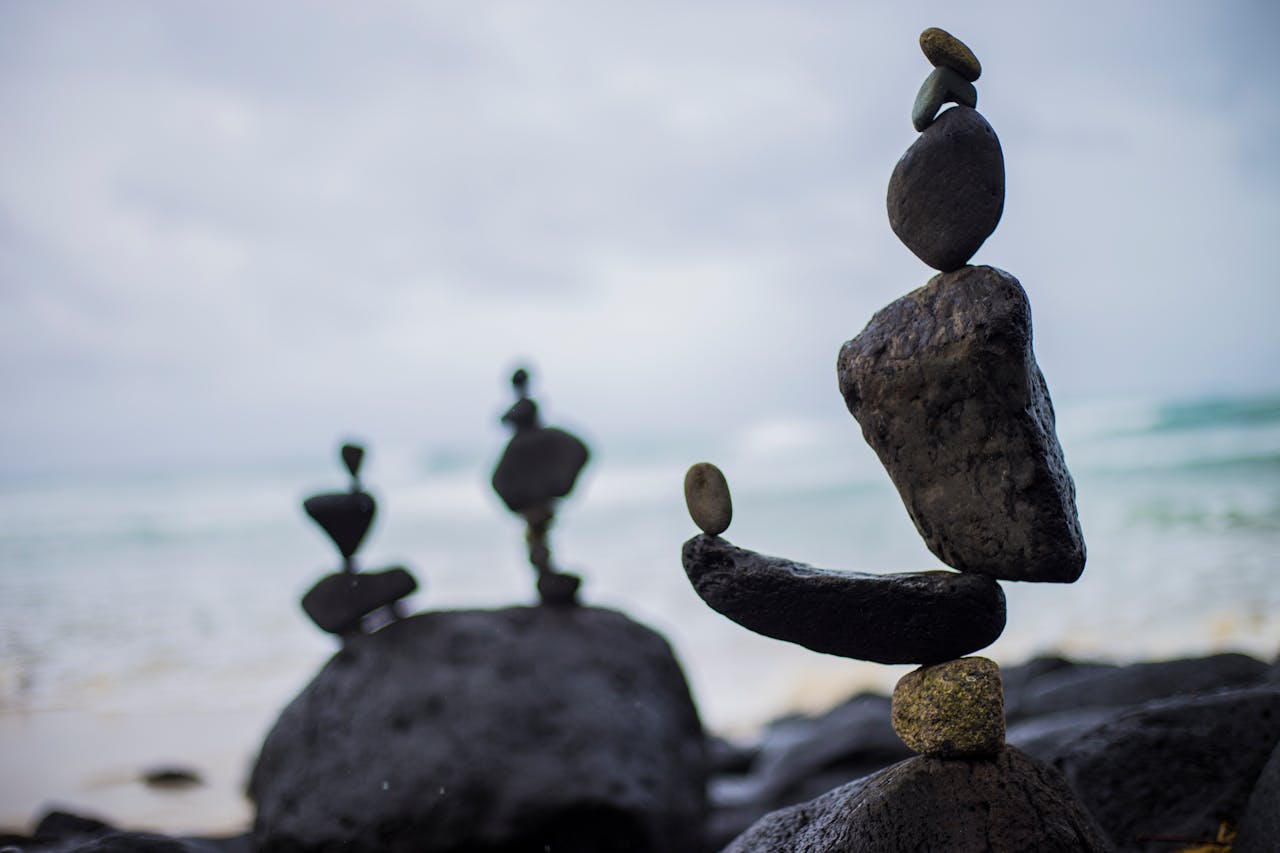
Meaning of Dreams According to Primbon Betaljemur: A Complete Guide to Understanding Dream Messages
1. Definition of Dreams According to Primbon Betaljemur

meditation (credit: pexels.com)
Primbon Betaljemur views dreams as a means of communication between the human subconscious and the spiritual realm. According to this ancient primbon, dreams are not merely meaningless sleep flowers, but contain important messages and clues for life. Dreams are believed to be a window to see future potential and warnings about things to be cautious of.
From the perspective of Primbon Betaljemur, dreams are manifestations of spiritual energy that permeates the human subconscious while sleeping. This energy carries symbolic messages that need to be interpreted. The interpretation of dreams according to this primbon is not done haphazardly, but follows certain guidelines and principles that have been passed down through generations.
Some basic principles in understanding dreams according to Primbon Betaljemur include:
- Each element in a dream has its own symbolic meaning
- The context and atmosphere of the dream greatly influence its interpretation
- Recurring dreams need special attention
- Dreams can serve as guidance for making decisions
- Not all dreams need to be interpreted; some dreams are random
By understanding these basic principles, one can begin to learn how to interpret dreams according to the guidance of Primbon Betaljemur. However, it is important to remember that dream interpretation still requires wisdom and should not be considered absolute truth.
2. History and Background of Primbon Betaljemur
Primbon Betaljemur is one of the oldest and most famous primbon texts in Java. This book is believed to have been first compiled during the Islamic Mataram Kingdom around the 17th century. The name "Betaljemur" itself comes from the word "Betal" which means book and "Jemur" which means bright or clear.
The compilation of Primbon Betaljemur is influenced by the acculturation of Javanese, Hindu-Buddhist, and Islamic cultures. This book summarizes various traditional Javanese knowledge including astrology, predictions, herbal medicine, and dream interpretation. The main purpose of its compilation is to serve as a guideline for the Javanese people in their daily lives.
Some interesting facts related to the history of Primbon Betaljemur:
- Originally written in Javanese script on lontar leaves
- Spread orally from generation to generation
- Started to be compiled into manuscript form in the 18th century
- Underwent several revisions and additions
- Translated into Indonesian in the 20th century
Although it has been around for hundreds of years, Primbon Betaljemur remains relevant and frequently referenced to this day. This book has become one of the main sources for studying local wisdom and the life philosophy of the Javanese people. Particularly in the area of dream interpretation, Primbon Betaljemur is considered one of the most complete and reliable references.
3. Types of Dreams in Primbon Betaljemur
The Betaljemur Primbon classifies dreams into several types based on their nature and meaning. Understanding these types of dreams is important for interpreting the messages contained within them more accurately. Here are some main types of dreams according to the Betaljemur Primbon:
1. Good Dreams (Impen Becik)
This type of dream is believed to bring signs of good fortune or happy news. It is usually marked by feelings of joy and comfort while dreaming. Examples include dreams of seeing bright light, dreams of ascending to high places, or dreams of meeting holy people.
2. Bad Dreams (Impen Ala)
Opposite to good dreams, this type is considered a warning of impending problems or disasters. Generally, it evokes feelings of fear or discomfort. For instance, dreams of being chased by wild animals, dreams of falling from heights, or dreams of being in dark places.
3. Symbolic Dreams (Impen Pralambang)
Dreams that contain hidden meanings and need further interpretation. They often use non-literal symbols. For example, dreaming of seeing twin moons could mean receiving abundant blessings.
4. Prophetic Dreams (Impen Wangsit)
Believed to be dreams that carry important messages or guidance from the spiritual realm. Usually experienced by certain individuals who possess high spiritual sensitivity. Generally causing feelings of fear or discomfort. For example, dreams of being chased by wild animals, dreams of falling from heights, or dreams of being in dark places.
3. Symbolic Dreams (Impen Pralambang)
Dreams that contain hidden meanings and need further interpretation. They often use non-literal symbols. For instance, dreaming of seeing twin moons could mean receiving abundant blessings.
4. Prophetic Dreams (Impen Wangsit)
Believed to be dreams that carry important messages or guidance from the spiritual realm. Usually experienced by certain individuals who possess high spiritual sensitivity. For example, a dream of meeting ancestors who give advice.
5. Ordinary Dreams (Impen Lumrah)
Dreams that occur as a result of daily activities and do not have a specific meaning. Often, these dreams are a continuation of thoughts or activities before sleeping. For instance, dreams about work for someone who is busy working.
By understanding these types of dreams, a person can more easily identify whether the dream they experienced needs further interpretation or is just an ordinary dream without specific meaning. However, it is important to remember that this categorization is not rigid, and sometimes a single dream can fall into several categories at once.
4. How to Interpret Dreams According to Primbon Betaljemur

Interpreting dreams according to Primbon Betaljemur is not a simple process. A deep understanding of symbols and the Javanese cultural context is required. Here are the general steps in interpreting dreams according to the Primbon Betaljemur guide:
1. Remembering Dream Details
The first step is to remember as many details as possible from the dream experienced. Pay attention to important elements such as:
- Characters or figures that appear
- Setting and time
- The atmosphere or mood of the dream
- The sequence of events in the dream
- The feelings that arise while dreaming
2. Identify Key Symbols
After recalling the details of the dream, identify the main symbols that appear. For example, if dreaming about a snake, pay attention to the color of the snake, its size, and what the snake is doing. Every detail can influence the overall meaning of a dream.
3.Understand Personal Context
Consider the context of personal life when the dream occurs. Are there specific issues or concerns being faced? Physical and mental conditions can also affect the dreams experienced.
4.Refer to Primbon Betaljemur
Use Primbon Betaljemur as a reference to find meanings of the symbols that appear in dreams. Note that one symbol can have several different interpretations depending on its context.
5.Analyze the Overall Dream
After understanding the meaning of each symbol, try to analyze the dream as a whole. How are the symbols related? What is the main message that the dream wants to convey?
6.Reflection and Introspection
Reflect on the meaning of the dream in the context of real life. Are there lessons or warnings that can be taken? Conduct self-introspection based on the message of the dream.
7.Consult an Expert
If you find it difficult to interpret on your own, you can consult with a primbon expert or someone more experienced in dream interpretation.
It is important to remember that dream interpretation remains subjective and should not be considered absolute truth. Use the results of dream interpretation as material for consideration, not as an absolute guide in making decisions.
5. Common Symbols and Meanings in Dreams
Primbon Betaljemur provides guidance on the meanings of various symbols that often appear in dreams. Here are some examples of common symbols along with their meanings:
1.Water
Clear water is often interpreted as inner peace and smooth fortune. Murky water can mean facing problems or trials. Overflowing water, like a flood, can be a sign of significant changes coming in life.
2.Fire
A small fire that burns brightly can signify enthusiasm and motivation. A raging fire can mean facing conflicts or challenges. Extinguishing a fire in a dream can mean being able to handle problems well.
3.Animals
Dreams about animals have various meanings depending on their type. For example:
- Snake: can mean hidden enemies or temptations
- Horse: symbolizes strength and progress
- Bird: often associated with freedom and aspirations
4.Vehicles
Vehicles in dreams often symbolize the journey of life. For example, driving a car can mean progress in a career, while a broken-down vehicle can mean obstacles in achieving goals.
5.House
A house often represents oneself or personal life. A clean and bright house can mean inner tranquility. A damaged or dirty house can indicate that there are problems that need to be resolved in life.
6.Numbers
Numbers in dreams also have their own meanings, for example:
- Number 1: symbolizes a new beginning or independence
- Number 7: often associated with luck
- Number 9: can mean the final phase or achievement
7.Colors
The dominant colors in dreams can also influence their meanings:
- White: purity, sincerity
- Black: mystery, uncertainty
- Red: passion, warning
- Green: growth, hope
It is important to remember that the meanings of these symbols are not absolute and can vary depending on the overall context of the dream. Accurate interpretation requires a deep understanding of the dreamer's conditions and background.
6. Benefits of Understanding Dream Meanings
Studying and understanding the meaning of dreams according to Primbon Betaljemur can provide various benefits for daily life. Here are some of the main benefits of understanding the meaning of dreams:
1.Self-Introspection
Dreams often reflect inner conditions and the subconscious mind. By understanding the meaning of dreams, one can engage in self-introspection and recognize hidden aspects within themselves.
2.Early Warning
Some dreams are believed to serve as warnings of potential problems or dangers. Understanding the meaning of dreams can help someone to be more alert and prepare to face challenges.
3.Inspiration and Creativity
Dreams can be a source of inspiration and creative ideas. Many artists and inventors draw inspiration for their work from dreams they experience.
4.Problem Solving
Sometimes solutions to problems being faced can emerge through dreams. Understanding the meaning of dreams can help find new perspectives in resolving issues.
5.Intuition Development
Studying the meaning of dreams can train one's intuitive sensitivity. The more often a person analyzes their dreams, the sharper their intuition becomes in understanding the signs of the subconscious.
6.Improvement of Sleep Quality
By understanding the meaning of dreams, a person can be more at ease when facing nightmares. This, in turn, can enhance the overall quality of sleep.
7. Spiritual Development
For some people, studying the meaning of dreams becomes a part of their spiritual journey. Dreams are seen as a bridge between the conscious and spiritual realms.
8.Cultural Understanding
Studying the meaning of dreams according to Primbon Betaljemur also means deepening the understanding of local wisdom and Javanese culture.
However, it is important to remain critical and not overly rely on dream interpretations when making important decisions. The meaning of dreams should be used as a complement, not a substitute, for logical and rational considerations.
7. Tips for Remembering and Recording Dreams

To interpret dreams well, the first step is to remember and note the details of the dream. Here are some practical tips to help you remember and record your dreams more effectively:
1.Prepare a Dream Journal
Provide a special notebook for recording dreams. Place this notebook next to your bed for easy access as soon as you wake up.
2.Set Your Intention Before Sleeping
Before sleeping, plant the intention in your heart that you want to remember your dreams. Visualize yourself waking up and immediately recording the dream.
3.Wake Up Slowly
When you wake up, do not move or open your eyes right away. Allow your awareness to come slowly while recalling the dream you just experienced.
4.Record Immediately
As soon as memories of the dream start to surface, quickly jot down the main points. Do not delay as memories of dreams can fade quickly.
5.Focus on Details
Write down as many details as you can remember, including colors, sounds, feelings, and the sequence of events in the dream.
6.Use Keywords
If you don’t have time to write extensively, use keywords that can trigger your memory when you analyze the dream further later.
7.Record Your Voice
Another alternative is to record your voice telling the dream using a smartphone. This can be quicker than writing.
8. Make a Sketch
If there are important scenes or symbols in the dream, try making a simple sketch of them.
9. Note the Date and Time
Always include the date and time when the dream occurred. This can help identify certain dream patterns.
10. Reflect on Conditions at the Time
Also note your physical and mental condition at the time the dream occurred, as well as any significant events that happened beforehand.
By regularly recording your dreams, you will become better at remembering the details of your dreams. This record will also be very useful when you want to analyze or look for patterns in the dreams you experience.
8. Comparison with Other Dream Interpretation Methods
The Betaljemur Primbon is not the only method for interpreting dreams. There are various other approaches used in different cultures and disciplines. Here is a comparison between dream interpretation according to Betaljemur Primbon and some other methods:
1. Dream Interpretation in Psychoanalysis
- Key figure: Sigmund Freud
- Focus: Dreams as manifestations of repressed desires and subconscious conflicts
- Difference from Primbon: Places more emphasis on individual psychological aspects, less consideration of spiritual factors
2. Dream Interpretation in Analytical Psychology
- Key figure: Carl Jung
- Focus: Dreams as messages from the collective unconscious, using the concept of archetypes
- Similarity to Primbon: Both consider symbolic and spiritual aspects
3. Dream Interpretation in Islam
- Sources: The Quran, Hadith, and Islamic dream interpretation books
- Focus: Dreams as one form of revelation or warning from Allah
- Similarity to Primbon: Both view dreams as having spiritual meanings
4. Dream Interpretation in Chinese Culture
- Sources: The Yi Jing and ancient Chinese traditions
- Focus: Dreams as messages from ancestors or indications of fate
- Similarity to Primbon: Both use complex symbol systems
5. Modern Dream Interpretation
- Approach: Using scientific research and technology such as brain scanning
- Focus: Dreams as a cognitive process for processing information and consolidating memory
- Difference with Primbon: Places more emphasis on neurological aspects, less consideration of symbolic meaning
Despite the differences, there are some common similarities between Primbon Betaljemur and other dream interpretation methods:
- Recognizing that dreams have meanings beyond mere random phenomena
- Using a system of symbols to interpret dreams
- Considering personal and cultural context in interpretation
Understanding the various methods of dream interpretation can enrich perspectives in interpreting dreams. Each method has its own strengths and limitations, and the choice of method used should be tailored to individual beliefs and needs.
9. Criticism and Controversy Surrounding Dream Interpretation
Although it has been used and trusted by many people for a long time, dream interpretation, including that based on Primbon Betaljemur, is not free from criticism and controversy. Here are some main criticisms of the practice of dream interpretation:
1. Lack of Scientific Basis
Criticism: Traditional dream interpretation such as Primbon Betaljemur is considered to lack a strong scientific foundation. Interpretations are often subjective and difficult to verify empirically.
2. Potential Confirmation Bias
Criticism: There is a tendency for people to only remember dream interpretations that "proved true" and ignore those that did not occur, creating an illusion of accuracy.
3. Overgeneralization
Criticism: Dream interpretations often overgeneralize, whereas the meaning of dreams can be very personal and contextual for each individual.
4. Risk of Dependence
Criticism: Relying too much on dream interpretations when making life decisions can overlook more important rational and logical factors.
5. Exploitation Potential
Criticism: Dream interpretation practices can be misused by irresponsible parties to exploit someone's emotional vulnerabilities.
6. Inconsistency Among Methods
Criticism: Differences in interpretation between one dream interpretation method and another raise questions about the validity of this practice as a whole.
7. Conflicting with Certain Religious Teachings
Criticism: Some religious sects view dream interpretation practices as a form of shirk or contrary to religious teachings.
8. Ignoring Psychological Factors
Criticism: Traditional dream interpretation often overlooks psychological factors such as stress, trauma, or sleep disorders that can influence dream content.
In response to these criticisms, proponents of traditional dream interpretation like Primbon Betaljemur usually argue that:
- Dream interpretation is a form of local wisdom that has stood the test of time
- Dreams have a spiritual dimension that cannot always be explained scientifically
- Dream interpretation should be used as a complement, not a substitute, for rational considerations
- Wisdom and experience are needed to interpret dreams accurately
Regardless of this controversy, it is important to approach dream interpretation wisely and critically. Use it as a material for self-reflection, but always prioritize logical and rational considerations in making important life decisions.
10. Common Questions About Dream Meanings

Here are some frequently asked questions regarding the meaning of dreams according to Primbon Betaljemur, along with their answers:
1. Do all dreams have meaning?
Answer: According to Primbon Betaljemur, not all dreams have a specific meaning. Some dreams are merely reflections of daily activities or physical conditions while sleeping. However, intense or recurring dreams are usually considered to have a deeper significance.
2. What if I rarely dream?
Answer: In fact, everyone dreams; it’s just that not everyone can remember their dreams upon waking. Try to train yourself to remember your dreams more often with the tips mentioned earlier.
3. Do nightmares always signify bad omens?
Answer: Not necessarily. Nightmares can be warnings to be more vigilant, but they can also simply reflect anxiety or stress being experienced. Personal context is very important in interpreting nightmares.
4. Is it okay to share dreams with others?
Answer: According to some beliefs, it is advisable not to share dreams before breakfast or before sunrise. However, there is no absolute prohibition against sharing dreams. In fact, discussing them with a trusted person can help understand the meaning of the dream better.
5. What if the dream interpretation contradicts my religious beliefs?
Answer: If there is a contradiction, prioritize your religious beliefs. Dream interpretations should be seen as additional insights, not as dogma that must be followed.
6. Is there a way to control dreams?
Answer: There is a technique called "lucid dreaming," where a person can become aware that they are dreaming and even control the course of their dream. However, this requires special practice, and not everyone can do it.
7.Why do dreams sometimes feel so real?
Answer: Very vivid dreams usually occur during the REM (Rapid Eye Movement) sleep phase. During this phase, brain activity is similar to when one is awake, making experiences in dreams feel very realistic.
8.Can dreams predict the future?
Answer: In Primbon Betaljemur, some dreams are considered to provide hints about the future. However, this is viewed more as a warning or inspiration, not a definite prophecy. A critical attitude is still needed in interpreting them.
9. What if I can't remember my dreams at all?
Answer: This is normal and does not need to be worried about. Try the techniques for remembering dreams that have been mentioned earlier. If you're still having trouble, make sure you are getting enough quality sleep as this can affect your ability to remember dreams.
10. Are there dreams that are considered taboo to interpret?
Answer: In Primbon Betaljemur, there are no dreams that are specifically considered taboo to interpret. However, interpretations of dreams related to death or disaster should be done with caution to avoid excessive anxiety.
11. Cultural Influences on Dream Interpretation
The interpretation of dreams is heavily influenced by a person's cultural background. Primbon Betaljemur, as a product of Javanese culture, certainly has unique characteristics that reflect the values and beliefs of the Javanese people. Here are some cultural aspects that influence dream interpretation in Primbon Betaljemur:
1. Javanese Syncretism
Javanese culture is known for its syncretism, which is the blending of various belief elements. In the dream interpretations of Primbon Betaljemur, we can find influences from animism, Hindu-Buddhism, and Islam. For example, dreaming of meeting ancestors can be interpreted as a spiritual message, reflecting the strong animistic beliefs still present in Javanese culture.
2. Concept of Balance
Javanese philosophy places great emphasis on balance or harmony. This is reflected in dream interpretations that often seek a balanced meaning between good and bad things. For instance, a falling dream, which is usually considered negative, can in Primbon be interpreted as a warning to be more cautious as well as a sign of a comeback.
3. Social Hierarchy
The hierarchical social structure of the Javanese also influences dream interpretation. Dreams of meeting a king or leader are often interpreted as a sign of receiving blessings or a promotion, reflecting the view that blessings flow from above to below in the social structure.
4. Nature Symbolism
The Javanese people have a special closeness to nature, and this is reflected in dream interpretations that are rich in nature symbolism. For example, dreams about mountains are often associated with aspirations or ideals, while the sea can symbolize deep emotions or spirituality.
5. Cyclical Time Concept
The Javanese view of time as cyclical or circular, rather than linear, influences dream interpretation. Dreams about the past or ancestors are not always seen as nostalgia, but can also serve as guidance for the future, reflecting the concept that the past, present, and future are interconnected.
6.Javanese Ethics and Morality
Javanese moral values such as politeness, harmony, and self-control also color dream interpretations. Dreams of doing things considered impolite or violating Javanese ethics are often interpreted as warnings to maintain proper behavior.
7.Belief in Supernatural Powers
Javanese culture has a strong belief in the supernatural world, which is reflected in dream interpretations that often link events in dreams with messages from the spiritual realm or supernatural beings.
8.Concept of Destiny and Fate
The Javanese view of destiny and fate, which is predetermined yet can be altered through effort, is reflected in dream interpretations that often provide warnings as well as guidance to change one’s fate for the better.
9.Respect for Ancestors
Javanese culture places great respect on ancestors, and this is evident in dream interpretations that often associate dreams of deceased individuals with important messages or advice.
10.Philosophy of Inner Spirituality
The teachings of Javanese inner spirituality, which emphasize the search for the meaning of life and spiritual perfection, also influence how dreams are interpreted, often seeking philosophical and spiritual meanings from the symbols within dreams.
Understanding these cultural aspects is important in interpreting dreams according to Primbon Betaljemur. Without an understanding of cultural context, there is a risk of misinterpretation or losing important nuances in dream interpretation. However, it is important to remember that culture is not a static entity. As time progresses, dream interpretations can also evolve, adapting to changes in values and worldviews of modern society.
12. The Relationship Between Dreams and Mental Health
Although the Primbon Betaljemur focuses more on the spiritual and symbolic aspects of dreams, it is important to understand the relationship between dreams and mental health from a modern scientific perspective. Here are some important aspects of the relationship between dreams and mental health:
1. Dreams as an Information Processing Process
Psychologists and neuroscientists believe that dreams play a crucial role in the information processing and memory consolidation process. During sleep, the brain processes and integrates experiences and information received while awake. Dreams can reflect this process, helping to organize and make sense of life experiences.
2. Dreams and Emotion Regulation
Some studies suggest that dreams have a function in emotion regulation. Dreams, especially those occurring during REM sleep, can help process and manage intense emotions. This may explain why we often dream about things that make us anxious or stressed.
3. Nightmares and Anxiety Disorders
Recurring and intense nightmares can be indicators of anxiety disorders or trauma. In some cases, persistent nightmares can even be a symptom of Post-Traumatic Stress Disorder (PTSD). Understanding and managing nightmares can be an important part of the therapeutic process.
4. Dreams and Creativity
Many artists and scientists report gaining inspiration or problem-solving ideas through dreams. This suggests that dreams can be a means to access creative and innovative thinking that may be blocked during waking conditions.
5. Lucid Dreams and Self-Awareness
Lucid dreams, where a person is aware that they are dreaming, have been studied as a potential tool for enhancing self-awareness and overcoming phobias or anxieties. Some therapists use lucid dreaming techniques as part of cognitive-behavioral therapy.
6. Dreams and Depression
Changes in dream patterns are often associated with depressive conditions. People experiencing depression tend to report more negative and distressing dreams. On the other hand, dreams can also be indicators of recovery from depression, with dream content becoming more positive as mental conditions improve.
7. Dreams as a Diagnostic Tool
In some psychotherapy approaches, dream analysis is used as a tool to understand the psychological conditions of patients. Although not as accurate as formal diagnostic methods, patterns and themes in dreams can provide insights into inner conflicts or unresolved issues.
8. Sleep Disorders and Dreams
Some sleep disorders such as narcolepsy or REM Sleep Behavior Disorder (RBD) can affect dreaming experiences. Understanding the relationship between sleep disorders and dreams is important for accurate diagnosis and treatment.
9. Dreams and Cognitive Development
In children, dreams play a role in cognitive and emotional development. Dreams help children process their experiences and emotions, as well as learn to distinguish between reality and fantasy.
10. The Effects of Medications on Dreams
Some types of medication, especially those affecting neurotransmitters in the brain, can influence the frequency and intensity of dreams. Understanding these effects is important in the context of psychiatric treatment.
Considering the close relationship between dreams and mental health, it is important to take these psychological aspects into account when interpreting dreams, including when using traditional approaches such as Primbon Betaljemur. The integration of traditional understanding and modern scientific perspectives on dreams can provide a more comprehensive and beneficial outlook on overall mental well-being.
13. The Role of Dreams in Personal Development

In addition to having spiritual and psychological meanings, dreams can also play an important role in the process of self-development. Here are some ways how dreams can be utilized for personal growth:
1. Dreams as a Mirror of Self
Dreams often reflect hidden aspects of our personality. By analyzing dreams, we can gain insights into traits, desires, or fears that we may not be aware of while awake. For example, recurring dreams about being trapped in a place may reflect feelings of being stuck in certain life situations.
2. Dreams as a Source of Inspiration
Many creative ideas and innovative solutions emerge through dreams. By paying attention to dreams, we can tap into unique sources of inspiration for various aspects of life, from art to everyday problem-solving.
3. Dreams for Overcoming Fears
In some therapeutic approaches, dreams are used as a means to confront and overcome fears. Techniques such as lucid dreaming can help a person confront and manage fear in a safe environment.
4. Dreams as a Tool for Meditation
Some spiritual practices use dreams as a form of meditation or contemplation. By reflecting on the meaning of dreams, one can deepen spiritual understanding and achieve personal insights.
5. Dreams for Enhancing Creativity
Many artists and writers use dreams as a source of creative inspiration. Recording and exploring dreams can open doors to new ideas and unique perspectives in their work.
6. Dreams as a Problem Solving Tool
Sometimes, solutions to difficult problems that are hard to solve while awake can emerge in dreams. This is because during sleep, the brain is free from the constraints of logical thinking, allowing for the emergence of out-of-the-box ideas.
7. Dreams for Developing Intuition
By regularly observing and analyzing dreams, one can sharpen their intuitive abilities. This can assist in decision-making and understanding complex situations.
8. Dreams as a Means of Catharsis
Dreams can be a channel for releasing repressed emotions and thoughts. This process can help reduce stress and achieve emotional balance.
9. Dreams for Enhancing Self-Awareness
Dream analysis can help individuals better understand their thought patterns, emotional reactions, and hidden motivations. This is important for deeper self-awareness development.
10. Dreams as a Tool for Future Planning
Some people use dreams as a way to visualize and plan their future. Dreams about aspirations or life goals can serve as motivation to realize them in real life.
To harness dreams for personal development, some practical steps that can be taken include:
- Regularly recording dreams in a dream journal
- Identifying recurring themes or patterns in dreams
- Discussing dreams with trusted individuals or professionals
- Using visualization techniques to "continue" dreams while awake
- Connecting symbols in dreams with real-life situations
- Experimenting with lucid dreaming techniques
- Using dreams as material for meditation or reflection
With the right approach, dreams can be a very valuable tool in the journey of personal development. However, it is important to maintain balance and not become overly obsessed with dream interpretation. Use insights from dreams as a complement, not a substitute, for other personal development methods.
14. Conclusion
The meaning of dreams according to Primbon Betaljemur offers a unique perspective in understanding the subconscious and spiritual messages that may be contained in dreams. Although rooted in ancient Javanese tradition and culture, this dream interpretation remains relevant as a means of self-introspection and understanding the dynamics of the human mind and soul.
It is important to remember that dream interpretation, whether according to Primbon Betaljemur or other methods, should not be considered as absolute truth or a definitive guide in making life decisions. Instead, dream interpretation is more appropriately positioned as a tool to enrich self-awareness and stimulate personal reflection.
In this modern era, a wise approach is to integrate traditional understandings like Primbon Betaljemur with scientific insights about the function of dreams in psychology and neuroscience. Thus, we can gain a more comprehensive and balanced understanding of the meaning and role of dreams in our lives.
Ultimately, what matters most is how we utilize insights from dreams for personal development and improving the quality of life. Dreams, with all their mysteries, remain a fascinating aspect of human experience that continues to invite exploration and contemplation.
(kpl/dhm)
Disclaimer: This translation from Bahasa Indonesia to English has been generated by Artificial Intelligence.


















